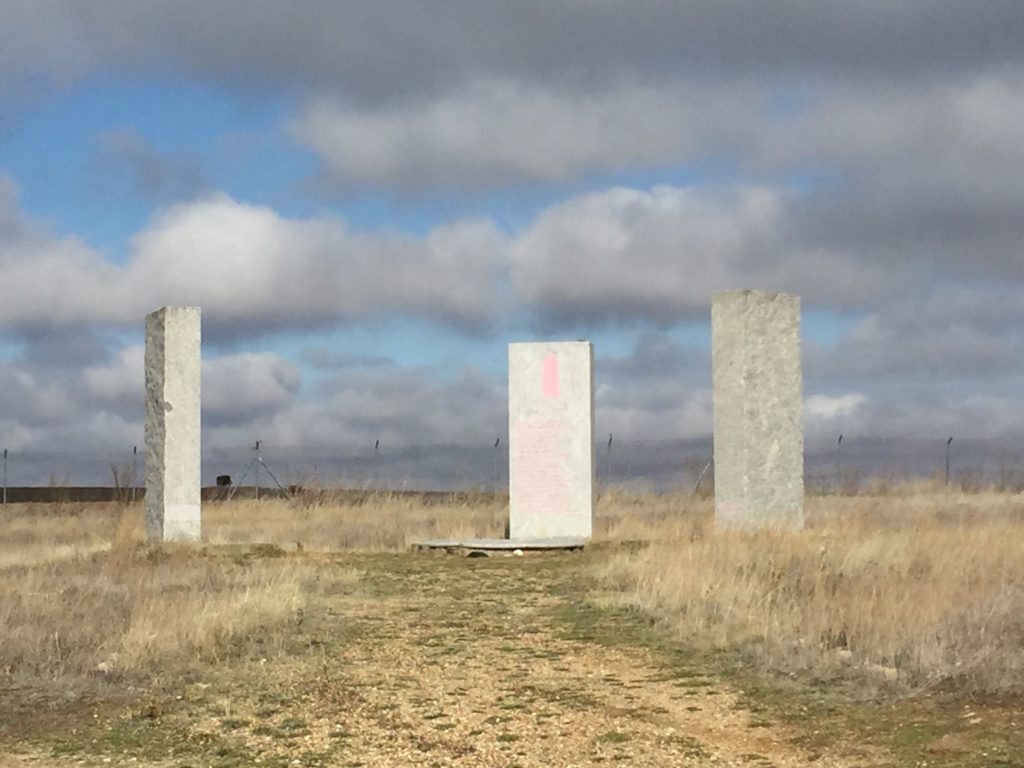
The life of a pilgrim regularly resembles the life of a soldier in terms of discipline, routine, marching long distances on foot, and living in very basic conditions with meagre rations for sustenance. The main difference is that on the camino no one is normally going to point a gun in your face. But there’s a first for everything. One Saturday in late October I was walking a lovely section between Santa Marta de Tera, a pretty little village in the middle of nowhere, to Rionegro del Puente, another pretty little village in the middle of nowhere, or Castilla y Leon to be precise. The path passed by canals, forests and cornfields, and after about 20 KM there was a dam and the promise of a walk by the waterside. What could be more enticing? As I neared the dam three trucks full of howling hounds passed by. A few minutes later the path was blocked with a sign saying “Entry Forbidden – Hunting”. This was the camino and nothing was going to prevent me getting to where I intended to go, so I carried on. A short distance later I was stopped by a bunch of guys clad in combat fatigues and carrying enough arms to constitute a national security risk. They told me I couldn’t pass through as they were hunting. “Find another route.” they said, but they didn’t say where. I refused to yield.
The hunters consulted with each other, told me to wait a moment and then one of them made a call. When he got off the phone he said they’d get a car to drive me across the hunting lands if only I’d wait for a few minutes. Normally a friendly gesture like that should be met with gratitude and good graces, but my first rule of the camino is “Thou shalt not take the bus or other forms of mechanised transport.” I had only a small smattering of Spanish, despite all my time in the country and in the company of its people, but if there was a confrontation to be had I knew that my limitations of language would be no barrier to my natural instinct to argue. In the best Spanish I could muster I said taking a car was not a possibility. I had walked to this point from Seville, and I was going to walk from here to Santiago. Cars were not an option. The hunters looked at each other in disbelief. One of them had a knife dangling from his belt which was even more menacing than the sinister glint in his eye. I was outnumbered by ten to one, and that didn’t even begin to take account of the hounds that were milling around and preparing for the chase. One bullet and the problem of the wayward pilgrim would have been solved. No one ever would have been the wiser. Eventually they decided that getting one of their gang to escort me through the lands was easier than shooting me. What they didn’t appreciate is that I would have taken the bullet. Nothing will stop a committed pilgrim on the road to Santiago.
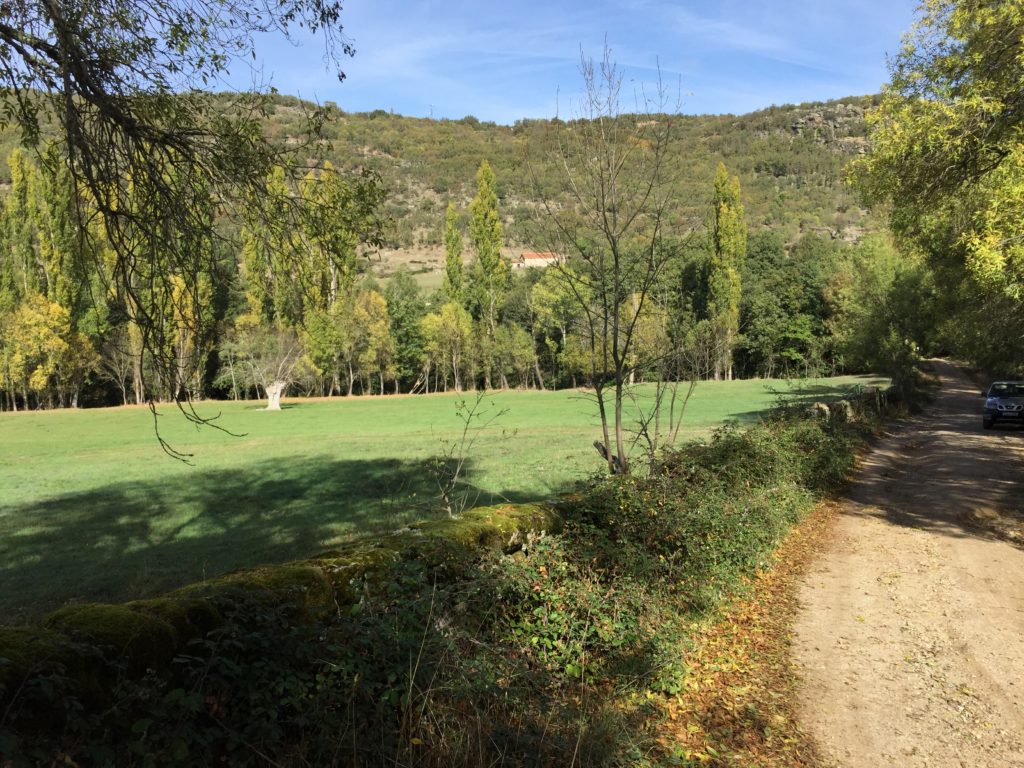
The region of Castilla y Leon is in many ways the middle child of all the caminos that cross its borders. It’s often overlooking, ignored, hurried over, and doesn’t always seem to sparkle with personality. Like a neglected middle child, if you don’t give it sufficient care it may turn around and threaten your existence, as the hunters could have done with me (but didn’t – they were actually quite accommodating in the end). But, with the right attention it could turn out to have many hidden talents and charms. You just need to try a little bit harder to find them under the surface. The Via de la Plata spends more time in Castilla y Leon than any other region, covering a distance of about 350 KM, and passes through the cities of Salamanca and Zamora, two of the many metropolitan jewels in Spain. Mountains have to be crossed to enter and exit the province, but once inside it’s mostly flat. Very, very flat. Welcome to the Meseta, the big sky country, and the home of the famed plains of Spain.
I had passed through Castilla y Leon on the Camino Francés, and had been warned about how monotonous the vast, featureless landscape could be. That was not my experience. For me, the Meseta was the centre of the universe. The even terrain made for ideal walking conditions, and the massive open skies above, alive with an ornithological symphony, with windswept cornfields, canals and small villages below, were the perfect accompaniments on my epic odyssey of the body and soul. The Via de la Plata enters Castilla y Leon from the south, and spends the first few days winding its way through deciduous forests and mountain meadows, where the peaks in the distance were dusted with snow. It was now the middle of October, and I was walking at an average altitude of 800 metres above sea level. Nights and early mornings were quite cold, and the heat of Andalucia and Extremadura was but a comforting memory.
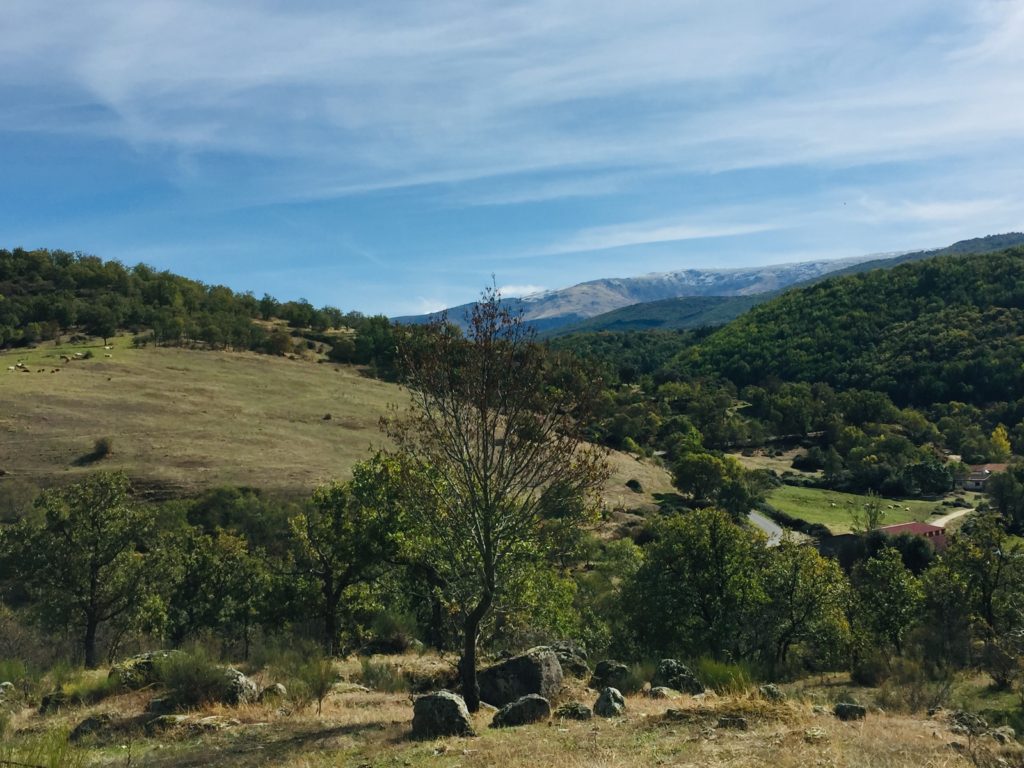
Following my final three long days of walking in Extremadura I decided to go at a more gentle pace for my first few days in Castile. I spent the first night in Calzada de Bejar, a small little mountain village where the main street was comprised of stone houses overlooked by wooden balconies. A friendly couple ran a cosy albergue and made sure we were all well fed. I did just 20 KM the following day to Fuenteroble, where I passed the afternoon in the local cafe discussing the daily news with my fellow pilgrims. Cafes were normally the only places to get WiFi and keep connected to an outside world that seemed a million miles away from these isolated hamlets. We were only tenuously aware of what was happening beyond our camino bubble, and for the most part we were happy to keep it that way. Less connectivity gave us more time to communicate with each other.
My fellow travellers at this stage were the two Daniels, one from Israel and one from Texas, two German brothers called Gunter and Horst, and a South African man, also called John. We snacked on tapas, drank a variety of alcoholic and non alcoholic beverages and discussed all manners of topics, from the serious to the frivolous to the absurd. When it came time to pay our bills, no one was out of pocket more than a few euros. It was hard to imagine that the owners of these establishments were making much of a living from them. Perhaps they kept them going because it gave them a reason to get out of bed in the morning, or they liked the company of the pilgrims or the few locals who still lived nearby. We often complained about Spanish business hours, or the tardiness of service, but if it wasn’t for the dedication of these cafe owners we wouldn’t have had anywhere to go in these towns at all.
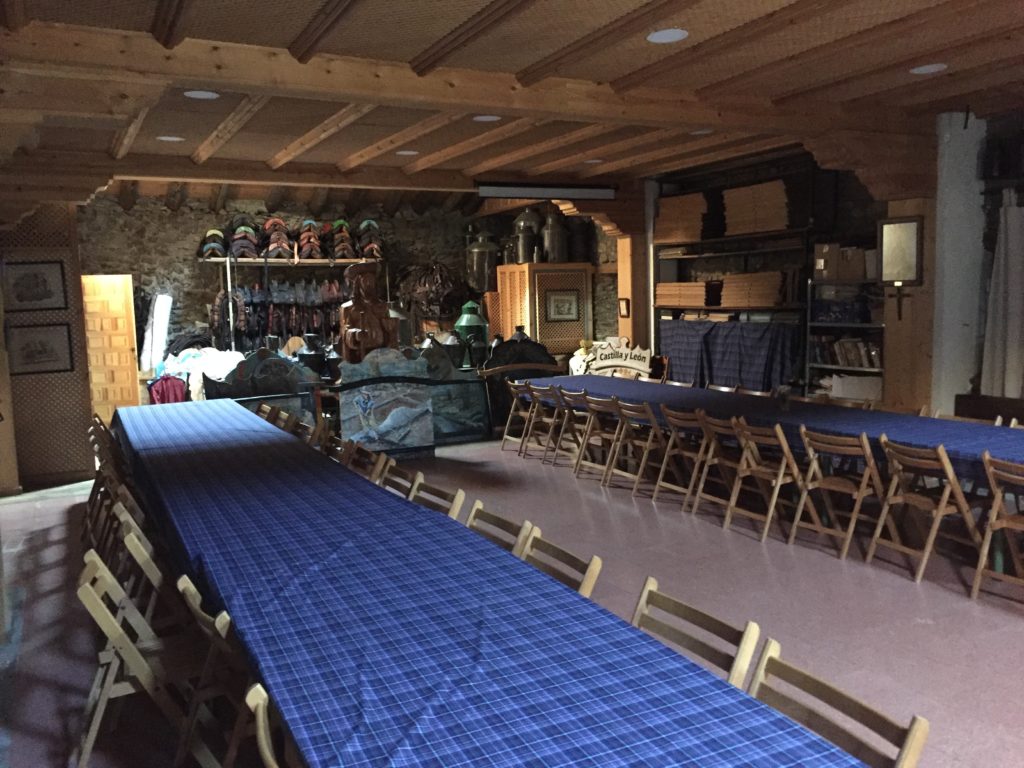
The albergue in Fuenteroble, which was one of the most famous on the Via de la Plata, was run by the local priest Fr Blas. It was housed in an intriguing building, full of curious statues and other carvings, and the dorms had a wood burning stove to keep them warm. A simple communal meal was supplied in the evening, consisting of soup and mushroom risotto. We all ate heartily and afterwards I said to a colleague that I thought the food was wonderful. He pointed out that I’d only been given some rice with mushrooms. It could be argued that standards and expectations are lower on a pilgrimage, where we have survive in conditions that are far more basic than our normal cosy lifestyles. However, I think it’s more likely that on the camino we have the opportunity to strip away the layers of complexity that shroud our lives and focus on what is truly important. Who really needs the moon and the stars when you have rice and mushrooms. And if you come to the realistion that rice and mushrooms are all you really need you have learned a very valuable lesson indeed.
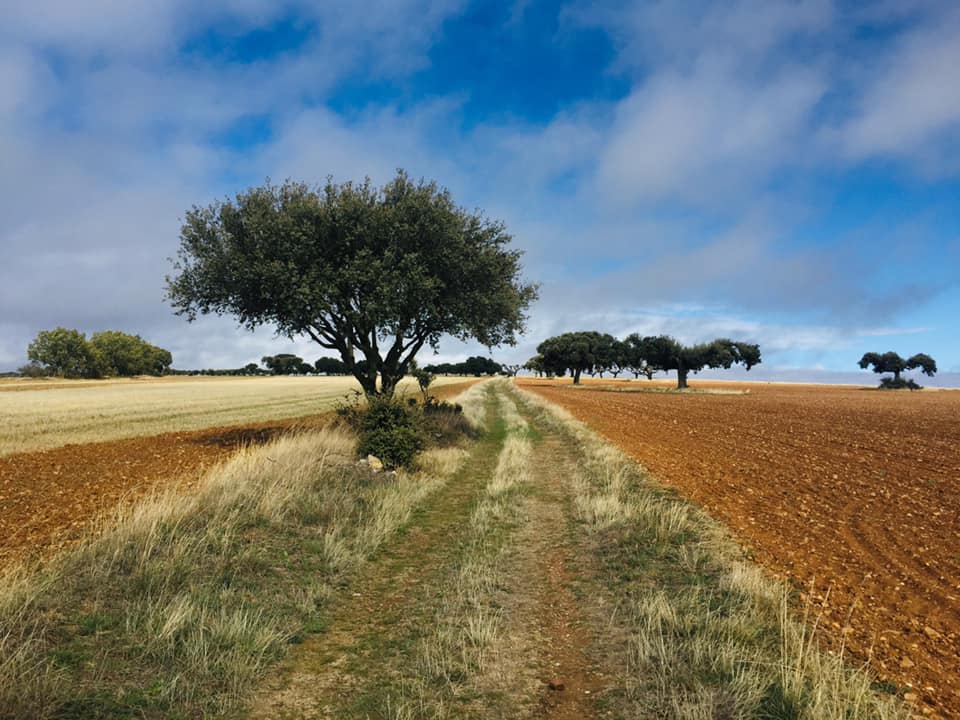
The Meseta, the Spanish name for the great plain, doesn’t begin properly until third day in Castile. The first few days in the province provide a pleasant mix of mountains, green fields and forests, but day three sees us reach the plains. And it was raining on the morning I was approaching them. How poetic! Eliza Dolittle selling flowers en route was all that was missing from the picture. Fortunately, the rains were not that severe, but before I got to the plains I first had to cross Pico de la Dueña, the highest point on the Via de la Plata so far. The peak was shrouded in mist, and as I approached the summit I was confronted by increasingly loud swooping, whirring noises. I was first confused about where their sounds were coming from, and then the propellers of windmills became vaguely visible though the dense fog. Windmills are a familiar sight on all the hills in these parts. Some decry their intrusion into the natural landscape, but if we want to maintain our energy intensive lifestyles without further polluting the planet we have to make a trade off between aesthetics and our continuing creature comforts. Personally, I’ve always been mesmerised by the sight of a collection of wafer thin windmills towering above the rolling plains of the the Meseta, rotating in unison. They were a hypnotic spectacle in a land of beautiful emptiness.
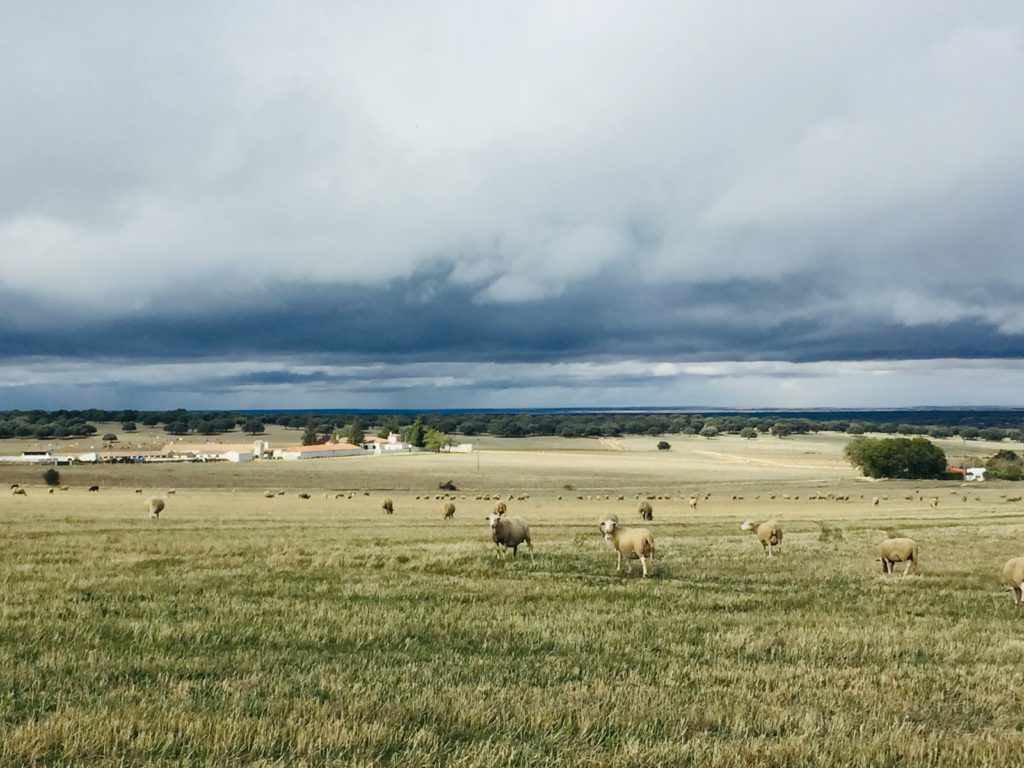
San Pedro de Rosados is the first village in the Meseta, and a classic example of what was to follow. The narrow streets are lined with red roofed adobe buildings. Dogs occasionally wander about, and a little bit of searching will find a small shop hidden in an unmarked building, but all other signs of life are non existent. I was walking with Dan from Texas at this point, and we decided not to stay in San Pedro but to go on a few more kilometres to Morille, which was reputed to have a nice albergue. Going the extra distance had the added advantage of shortening the following day’s journey into Salamanca. We picked up the key to the albergue from the local bar, where a particularly disinterested young man wrote our names in the ledger without even bothering to look away from his phone. Even by Spanish standards he was especially brusque. Dan and I saw no alternative other than be amused by his demeanour. Getting annoyed by such petty inconveniences is a luxury you can gladly shed on the camino.
The albergue was big, cavernous and awkwardly designed, but it was home for the evening. Daniel from Israel and John from South Africa joined us later, and we had the entire place to ourselves. The four of us went to the cafe to wile away the hours, and we were promised that they would serve dinner at 7pm. At 6:30 Israeli Daniel decided he’d had enough of waiting and insisted that they start serving dinner immediately. The girl behind the bar, busily ensconced in her phone, said “7pm”. Daniel again insisted “Now!”. She smiled and played hard to get, but Daniel was not going to give in so she eventually relented. However, given the speed of Spanish service it was still 7 before our food got there. We ate well and enjoyed good conversation in yet another bar in the middle of nowhere, or, depending on your perspective, in the centre of the Universe. The moment was tinged with a certain amount of sadness for me as this group was going to disperse once we reached Salamanca the next day. Nothing on the camino or in life is permanent, so we simply have to make the best of the continuing series of present moments we are given. The two Daniels and I had one final pilgrim’s meal together the following lunchtime in Burger King, and then we each continued along our own separate path.
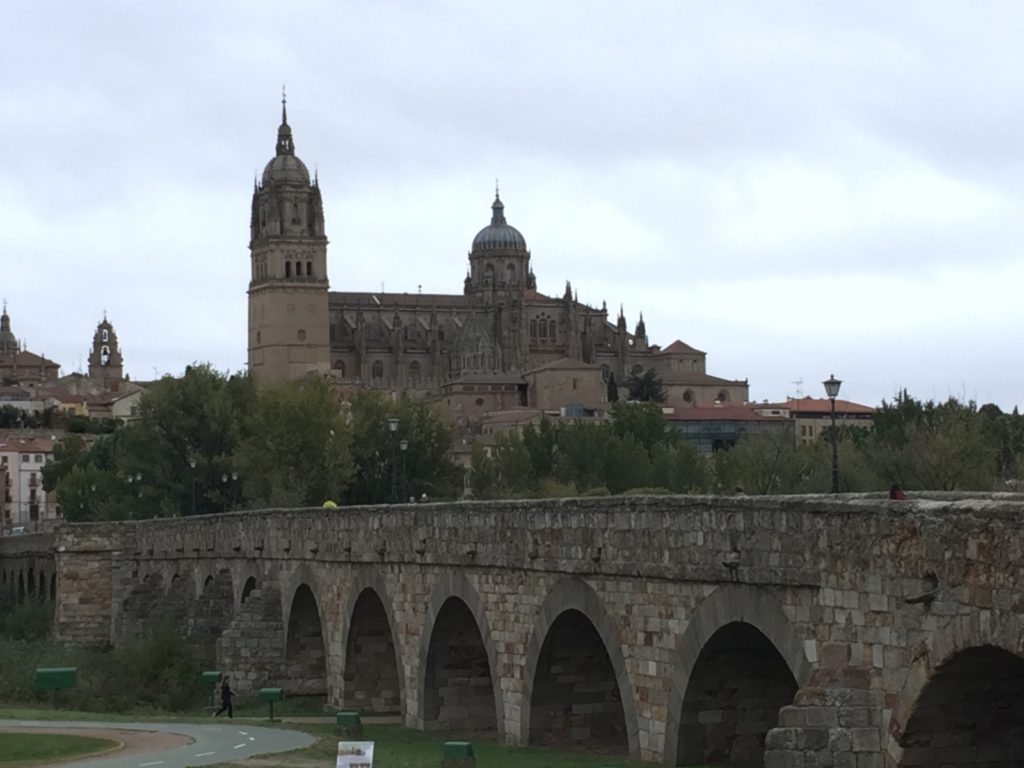
And so the road led to Salamanca. Along with Oxford, Cambridge and Bologna, this is one of Europe’s great university cities and it is one of the cultural and historic high points of the Via de la Plata. A UNESCO World Heritage Site (what in Spain isn’t?), the city has two cathedrals – an old Romanesque one, and a larger late Gothic one which was built in part to prop up its older neighbour – one of the most impressive Plaza Majors in all of Spain, and an 800 year old university with 28,000 students. After a week in comparative isolation, Salamanca was an exciting and inviting metropolis. This city had so much to offer I decided to spend an extra day there to explore all its charms and attractions, among which was a massive supermarket that was always open for business.
I met a friend on the evening I arrived, who was a native Salamancan, and she gave me a wonderful guided tour of the city, detailing its history and its cultural idiosyncrasies. The story of the frog is one of Salamanca’s most interesting tales. Around the entrance to the university lies a series of ornate stone carvings. A small frog is one of the many features. Legend dictates that incoming students who can find the frog will enjoy great academic success. I tried to find it and failed, but as I’d already graduated from college it wasn’t really going to affect my studies. The monumental 16th century cathedral is a smorgasbord of artistic delights, and it displays a variety of architectural styles from the Renaissance to the Baroque. On very close inspection of the building’s many features you can see sculptures of an astronaut, and a gargoyle eating an ice cream. These oddities were added by modern day stone masons doing restoration work.
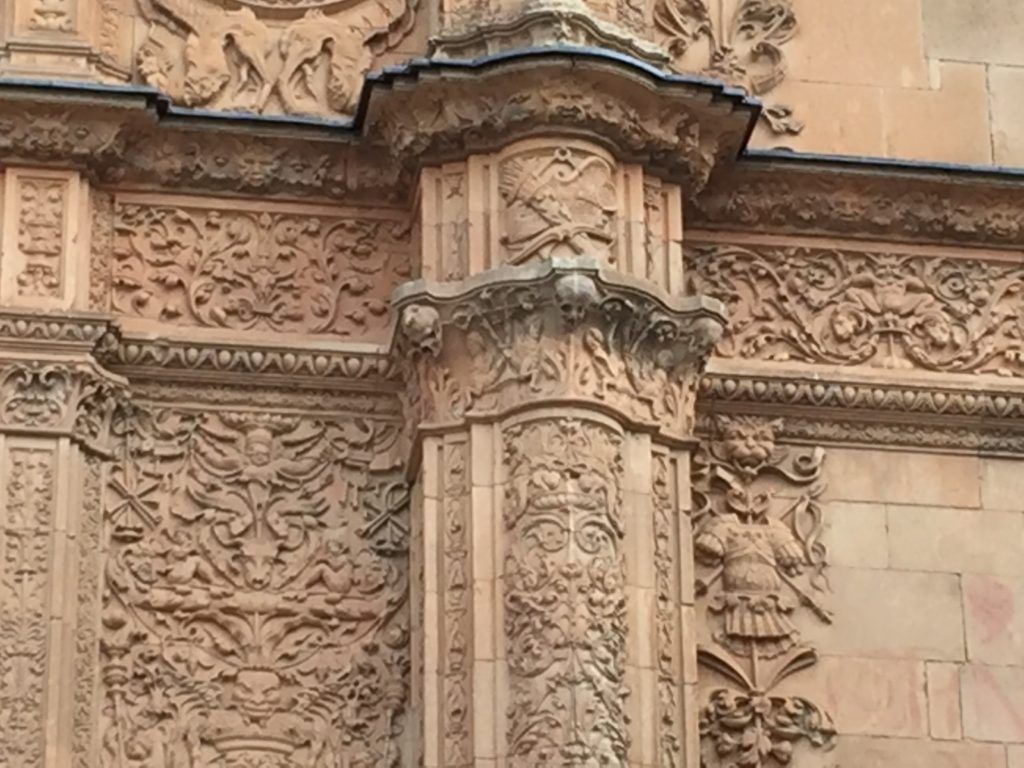
I spent the two nights in a private hostel, where for a 24 hour period I was no longer a pilgrim. I had reached the halfway point on the Via de la Plata and for one day I had earned the right to unburden myself of my backpack and walking sticks, and stay in bed later than 6 AM. I sat in the lounge of the hostel in the evening, and chatted with some of my fellow residents. One person said he was from Galicia, and I said I was heading in that direction and expected to get there in about 10 days. “Ten days?” he said. “How’s it going to take you ten days? Are you walking?” Without thinking I replied, “Yes. Of course.” I was met with a series of bewildered looks. “I’ve already walked here from Seville.” Those bewildered faces transformed into complete shock, and my comments were greeted with stunned silence. It was only then I realised that I was in the company of normal people for the first time in three weeks. These people hadn’t shared the same road as me, and hadn’t endured the challenges and demands of the camino. They weren’t part of the fraternity of crazies who walked the length and breadth of Spain just for the fun of it.
I regaled these people with tales of my adventures along the way, but I became increasingly conscious of the fact that they and I occupied different realities. There are two types of people in this world: those who have walked the camino and those who haven’t. A pilgrim spends a lot of their time outside conventional society, living a life of enforced simplicity, where their characters are stripped down to their basic constituents in an effort to discover their true values and purpose. I was a pilgrim and could never easily live among normal people again. Those two groups will always be friends, but latter will never fully understand the former. When you come to the realisation that your experience of the way will always make you an outsider there is only one thing you can do: you walk on. You’ll find your tribe along those empty roads that seem to lead to nowhere.
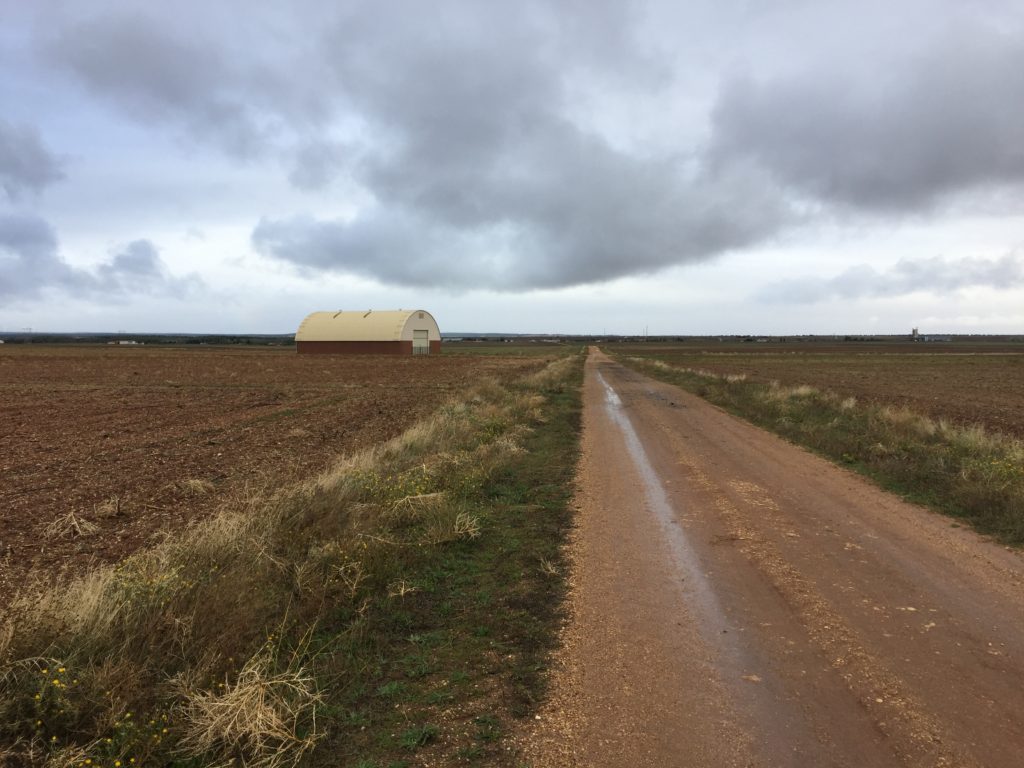
When I did return to the camino on a chilly Sunday morning, those empty roads led to a curiously named village called El Cubo de Vino (the Wine Cube), about 36 KM from Salamanca. There was a threat of rain lingering about as well, though thankfully it stayed away for most of the time I was on the road. The vast uninhabited plains of flat nothingness become very apparent once you progress further and further from the city. The path runs parallel to a busy road for much of the day, but apart from acres of corn, furrowed fields and a prison in the distance, there is little else around here to break the monotony. I saw just one person along this section. We’d never met before, but he knew my name was John and I knew his name was Alex. There’s a kinship among pilgrims that normal folk will simply never understand. (Alex and I actually had mutual friends, Janell and Tony from California, who I’d encountered again the previous day in Salamanca. They told me to look out for Alex. They obviously told him the same about me.)
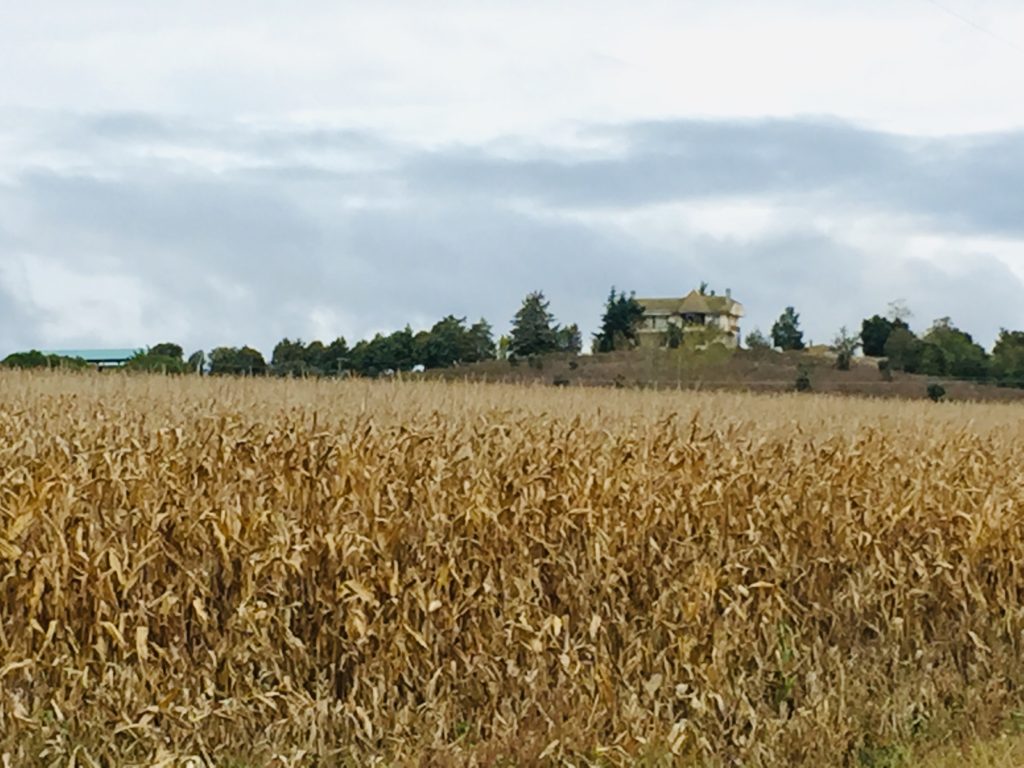
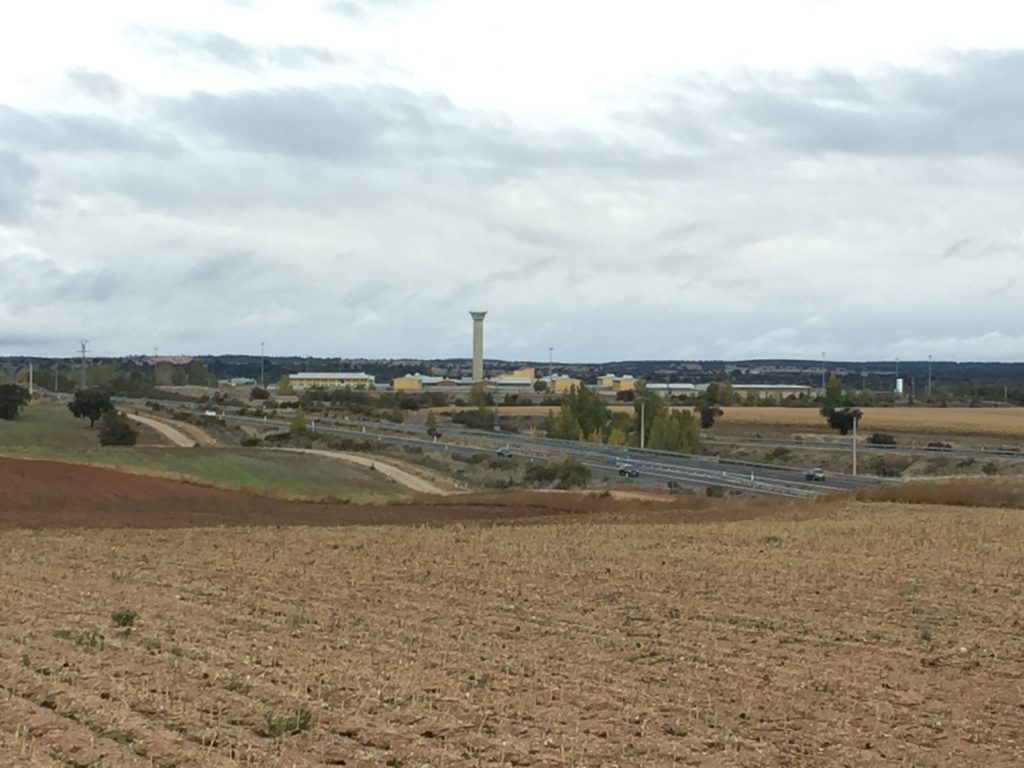
I saw nothing resembling wine or cubes in El Cubo de Vino, but I did meet a selection of new pilgrims from as far away as Russia and Japan. We shared a communal meal in the lodgings that evening where we were joined by a French man called Bruno, who was travelling on foot from the Black Sea to the Atlantic. He had already walked 5,000 KM, making my goal of 1,200 KM look very minor indeed. At this stage of his journey he looked like little more than a bag of bones that had some flesh coloured make up applied to it. What he was chasing after, or running away from, I didn’t discover, but I really did admire his courage, tenacity and sense of adventure. While pilgrims have a clear destination and a designated path, Bruno had to determine all of that for himself. His body was weakened and battered from his experience, but he still kept on going. If I ever had any doubts about my own resolve to complete the Via de la Plata, I only had to think about how Bruno was taking four steps for every one I took. That made my plight a whole lot easier.
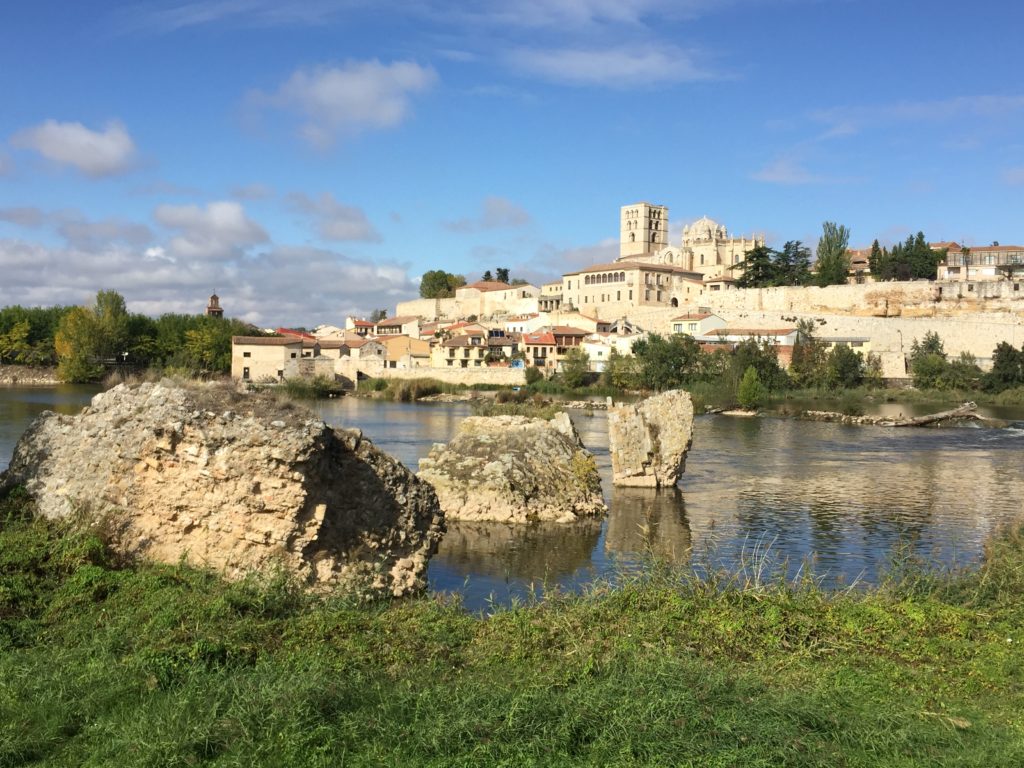
Along a path as isolated and remote as any I’d walked (and that was saying something on this pilgrimage), I reached beautiful little city of Zamora. Perched on the banks above the Rio Dueno, this place is packed full of Romanesque churches and buildings, a Renaissance cathedral, and a forbidding citadel, and it hosts an albergue that was perhaps the friendliest and most hospitable along the whole way. The hospitaleros, a Spanish man called Jorge and a Canadian named Paul, prepared a fine dinner for the assembly of pilgrims, each of whom brought some other offering to the table as well. And just to illustrate how small a world we inhabit, Paul’s uncle lived in my neighbouring parish back in Cork. I didn’t know the man, but I suspect we would have had friends – or enemies – in common. His uncle was a lawyer after all, and who really likes lawyers? Answer: no one. Not even lawyers.
After Zamora I wasn’t due to encounter anything resembling more than a one horse town for about ten days, and I still had around 400 KM to go before I reached Santiago. The temperatures were getting cold as I headed further north, though the weather gods were generally being kind by keeping the rain at bay. The brown ploughed fields of the Meseta were in part hypnotic and monotonous, yet the walking was normally flat, easy and confined to dirt tracks and away from busy roads. As always, there were scores of windmills on the horizon, and the camino frequently crossed over new tracks for the high speed train line between Madrid and A Coruna that was under construction. This would become a regular sight, as well as an obstruction, in the weeks to come.
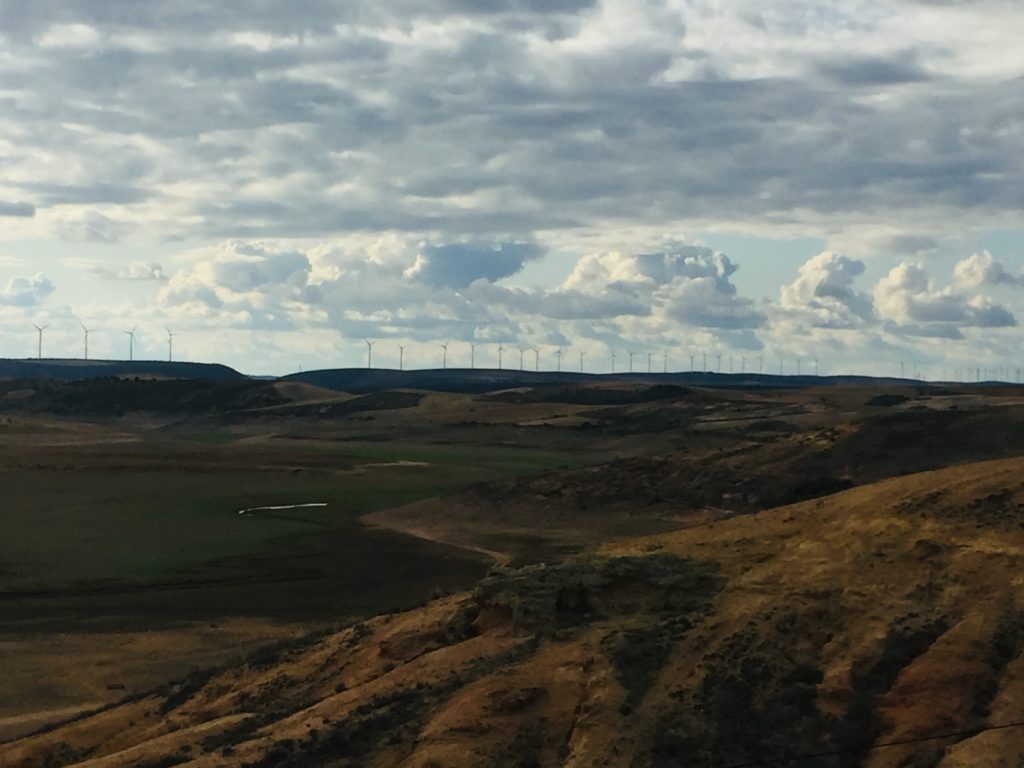
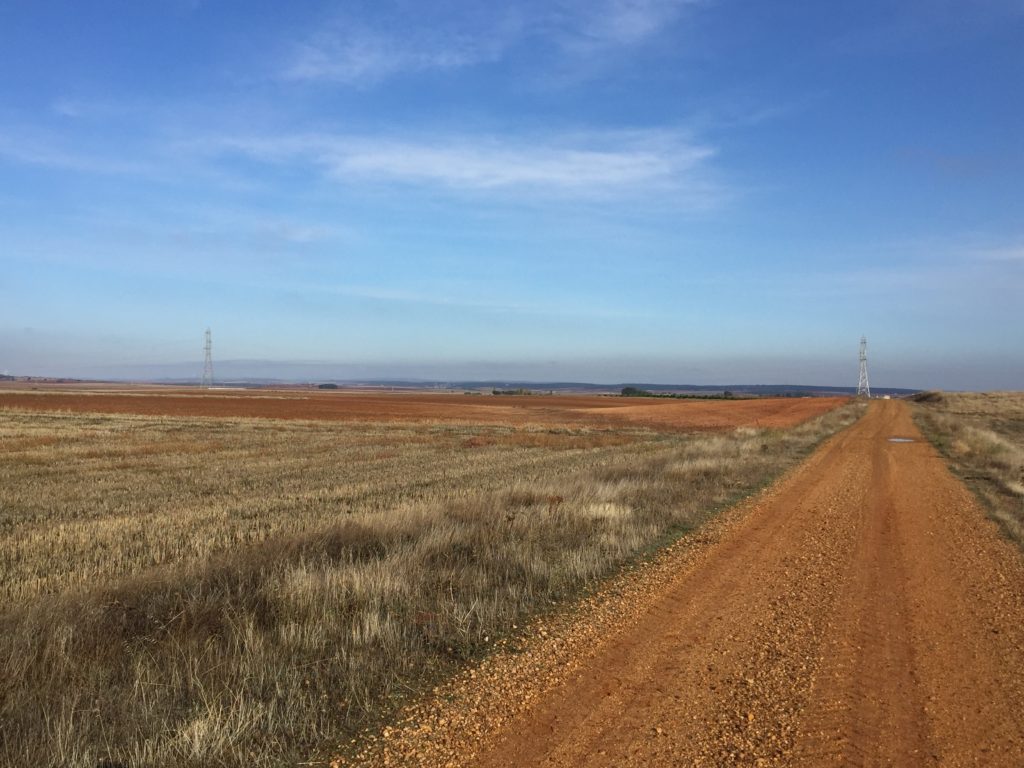
I took shorter days again for a while, spending the night in Montamarta in a drafty old school house, following a walk of just 20 KM. I was the only non Spanish speaker in that albergue, and for a while I felt like I would be totally alone due to my linguistic limitations. It is said that the regular Camino is called the French way, it’s virtually all in Spain, yet everything is communicated through English. Not so on the Via de la Plata. I found myself sharing the dining room of the albergue with a Spanish lady called Paqui, who I had seen several times along the way during the previous week but we had never spoken. She didn’t speak any English, and I was never confident about using what little Spanish I had. And it was very little indeed. But this was a situation where I had to try, and so I did. We managed a conversation, I understood most of what she said, and she me, and we ended up becoming friends. I discovered that not having a common tongue is rarely a barrier to communication. Even when we don’t always share the same mode of speech we normally have a fairly good idea what other people are saying to us. With just a willingness to try we can overcome any cultural contrasts that divide or differentiate us, and can appreciate the common humanity we all share
At that albergue in Montamarta we were joined by another funny Spanish woman called Amparo. She didn’t speak any English either, and I didn’t understand a word she was saying, but we became friends anyway. I also made two other good friends along this section; a German woman called Ellen, and Peter from Denmark. We all bonded into a nice group over the next few days. In the albergue in Granja, the next town after Montamarta, I met a trio of women cycling from Switzerland to Portugal who called themselves the three grandmothers. One of the ladies, who was in her late 70s, said she hoped to be still doing this in another 20 years. A few days later I met an Austrian man called Herman who was walking the Camino Levante, a monumental walk from the eastern Spanish coast which made the Via de la Plata look like a Sunday stroll in the park. Herman was 79 years old, was covering 30-40 KM per day, and he was on his 18th camino. These people were truly inspirational. When I did the Camino Primitivo a few years earlier I heard tales of an 86 year old man along the same path, however he could only manage 20-25 KM per day. Some people just don’t make any effort.
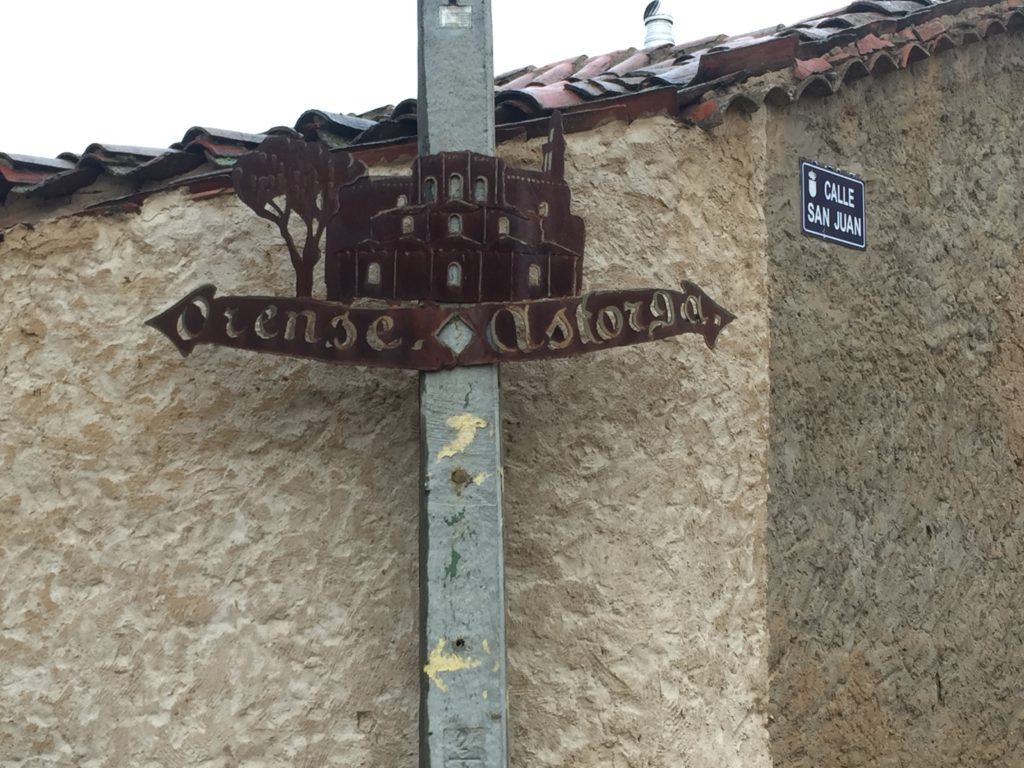
At Granja de Morerula, the camino splits in two and so I had to make a significant decision: do I head north to Astorga and join the Camino Francés for the remainder of the journey to Santiago, or do I travel west along the road to Ourense, via a path called the Camino Sanabres? Both routes were about the same distance, but I had already completed the stretch from Astorga to Santiago twice, so I thought a change of scenery would be welcome. By choosing the Sanabres it meant that from the moment I left Seville until I reached Santiago I would be travelling down roads I hadn’t walked before. By seeing a new world you also get to see the world anew, so I turned left at the split.
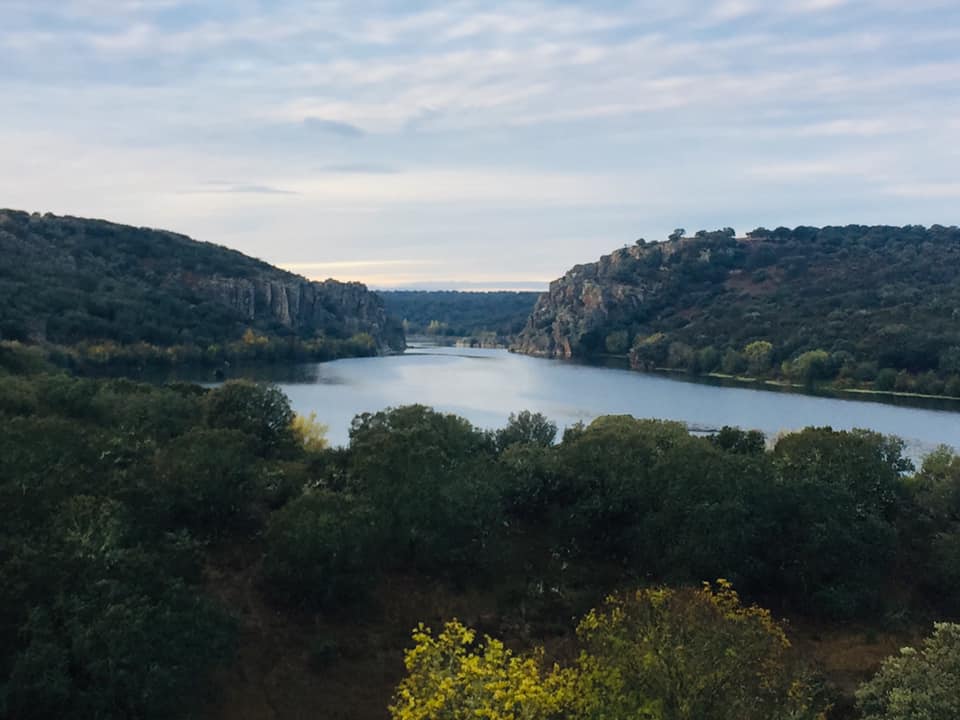
In the early hours of the morning I took my first steps along the Camino Sanabres. At first the landscape contained the usual mix of cereal fields and scrub, but the ground undulated more than normal and was significantly more verdant. Following a sudden dip in altitude I found myself walking through a gorge carved by the Rio Esla. It was like stumbling across another oasis in the desert. This completely unexpected sight was a most delightful surprise. Walking on the rugged banks of the river proved a little difficult, and I needed to watch my step carefully, but the aquatic scenery was a refreshing tonic for the soul. The countryside returned to the familiar flat fields on reaching the other side of the gorge. Though less striking, the limitless sweep of the open country was every bit as beautiful. These are the lands of the unreachable horizon, where you are confronted with how small you truly are in the grander scheme of things, but you can also take solace from realising that you are also a part of a much greater whole.
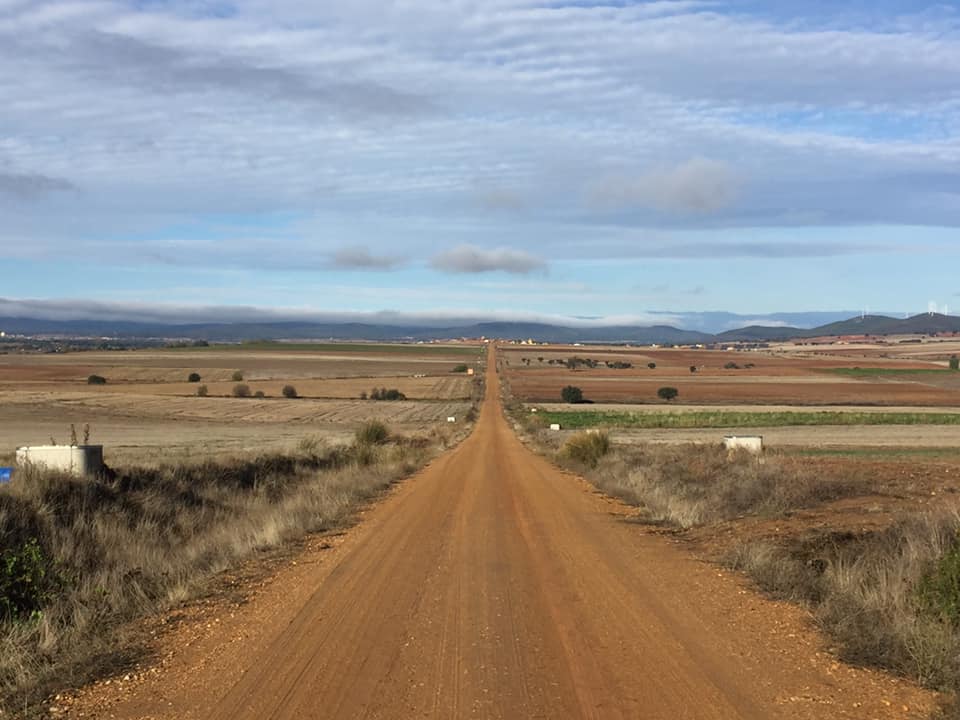
The next albergue, at Tabara, was run by a camino veteran called Jose, who provides legendary hospitality to pilgrims, and serves evening dinner and breakfast for those in his care. He had also written several books about the camino, which contained his insights and nuggets of wisdom gleaned from his many experiences. He shared those with us over a home cooked meal of paella. A new gang of pilgrims also appeared in Tabara, who had taken an alternative route from Montamarta. They were a mixture of Spanish, Italians and Argentinians, and, unfortunately for me, their English was quite minimal. But as always we got by. Ellen, Peter, Paqui and Amparo also stayed at that albergue, and at dinner that evening Peter started to look at the Argentinian man, Gustavo, with intent. Gustavo similarly started to suss out Peter. No one paid any particular attention for a while, and they both carried on eating, but eventually they spontaneously realised that they had both met on the Camino Primitivo a few years before. Gustavo’s travelling companion was a Spanish man called Antonio, and it transpired he had crossed paths with Herman, the 79 year old Austrian veteran, on a previous camino too. Such serendipitous moments are the spice of life.
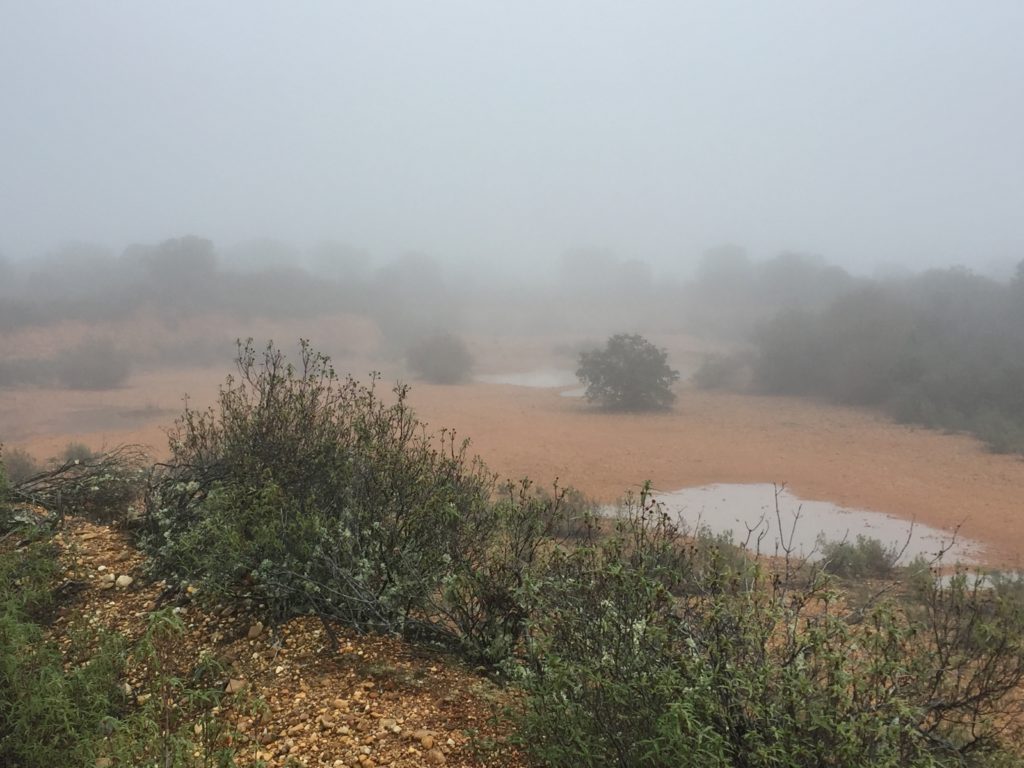
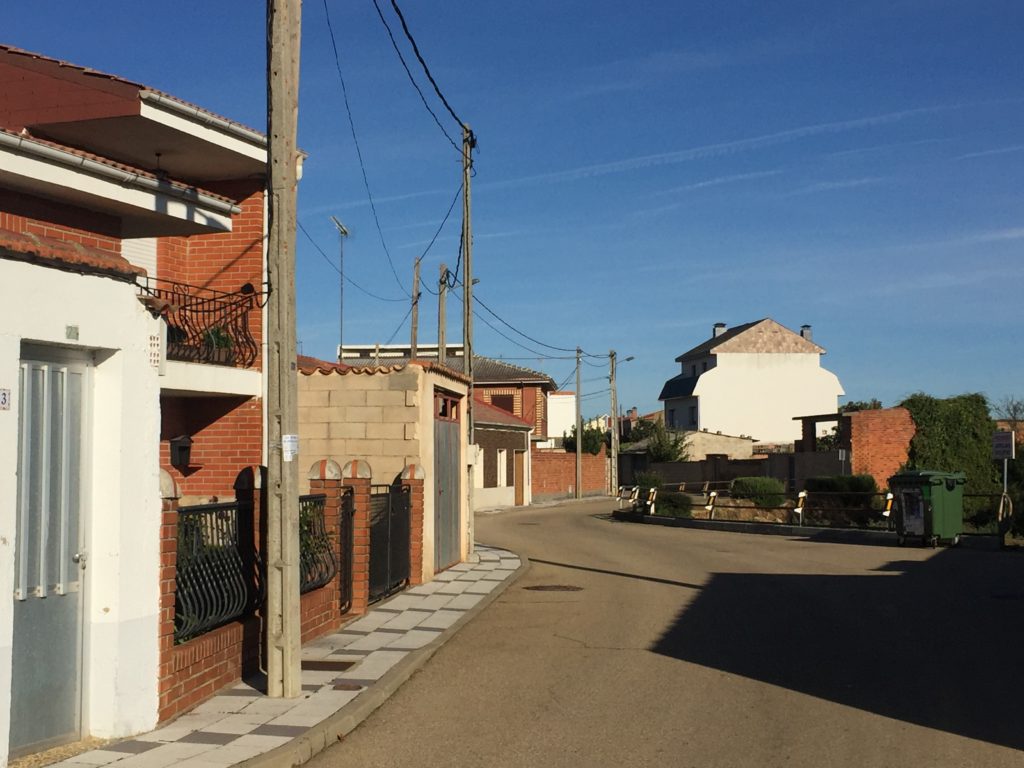
The dusty scrublands beyond Tabara led to the dusty hamlet of Santa Marta de Tera, famous for having one of the oldest statues of Santiago. It had a nice modern albergue, a shop that had no frontage and was so furtively located it felt like you needed a password to enter, and a cafe where it was actually possible to get something to eat at a reasonable hour. Dan from Texas reappeared at this place. I hadn’t seen him since Salamanca. A Frenchman called Frederick also joined us. He asked me where I was heading the next day. I told him I planned to go to a town called Mombuey. With an exasperated look, he forbiddingly waved his finger at me. “No, no, no, no,” he said. “You’re not going to stay in Mombuey.” The albergue there had a reputation for being infested with bed bugs, among its other features. Word on the street was stay away. Bed bugs seemed to be as common as blisters for some on the camino, but to date I had never had the pleasure. There had been nights when the person in the bed next to me had been devoured, and yet I awoke without a scratch. However, I didn’t want to tempt fate, so I took his advice and decided to avoid Mombuey.
This decision created an attendant dilemma: there was just one shop between Santa Marta and Mombuey, 36 KM away, and nothing from there to Pueblo de Sanabria, a further 31 KM after that. If I didn’t stay in Mombuey I’d have to stay in Rionegro, a short enough day of only 27 KM, and a village which supposedly had a nice new albergue and one of the best restaurants in that part of Spain. That part sounded fine, but as Rionegro had no shop it meant I’d have to go 40 KM the day after, and there would be no place to buy supplies as it was a Sunday. It was a choice between bedbugs or possible starvation. I decided to choose the latter, trusting that the Universe would provide. I didn’t anticipate I’d have to negotiate my way through a gathering of hunters as well.
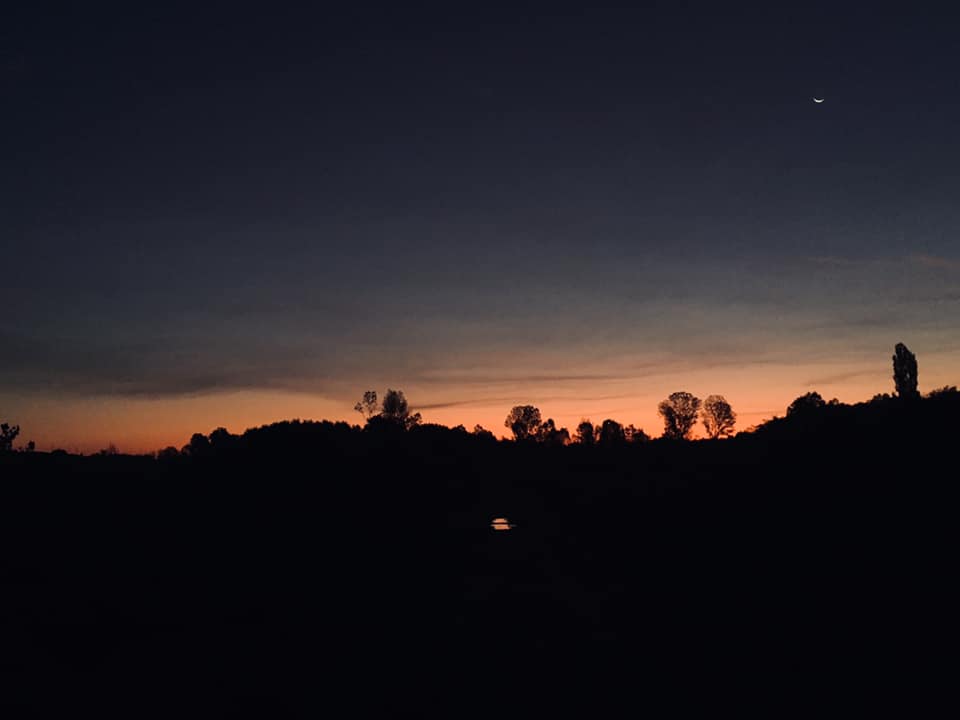
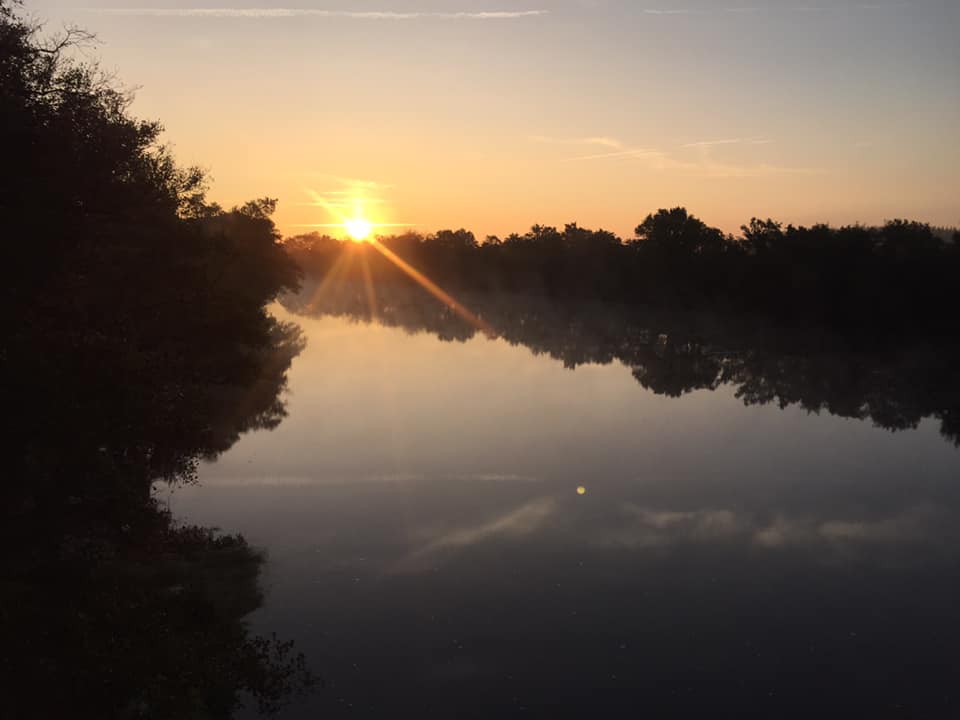
Mornings in the Meseta can be brutally cold, and as I had arrived in southern Spain in September I’d brought clothes to combat the heat of Andalucia and not the Baltic climate I had to endure in the elevated plateau where I now found myself. I often had to turn a pair of socks into makeshift gloves to keep my fingers from seizing up as I hadn’t brought any gloves, and I was unlikely to find any shop to buy them in these parts as it was already a challenge to find a place to buy food. Walking in the darkness had become a regular feature of this camino, and I had just a weak head torch to find the path and navigate the my way through the pre dawn fog. On this particular morning the sunrise was a glorious sight. The dark star encrusted sky receded as tones of crimson and then gold glittered across the heavens. I walked through poplar plantations, corn fields and along the sides of narrow canals as the daylight slowly started to illuminate the path ahead. It had all the hallmarks of a lovely day. There were gradual, subtle changes in the vegetation and landscape, indicating that we were slowly coming to the end of Meseta and heading into the mountain range known as the Cordillera Cantabrica.
After a two hour hike the camino skirted the village of Calzadilla de Tera. This place had the only open shop for the next 60 KM, so I left the path and navigated my way through the warren of empty streets in search of it. I saw one or two old people enjoying the early morning air, but like so many Spanish villages this place was also fading into oblivion. The streets didn’t seem to follow any particular pattern, so I had to walk about and hope that I would eventually find the shop, and eventually I did. And it was closed. My watch said 10 AM, and even by Spanish time the place should be open. The iron grating at the front was raised to about hip height, but there was no sign of life. I did a short walk around the block and hoped that the place would be open when I returned. If not, I’d have to march a long way the next day on an empty stomach. Or, I could head for Mombuey and take my chances in the albergue from hell. I would get food there, but I might also turn into the main course for the bedbugs.
After doing my laps I returned to the shop. Still closed. There was a doorbell, so I rang it. A window opened across the street and a woman put her head out. I gathered she said she’d be across in a minute. She graciously opened up, and I bought whatever I could from the limited range of supplies, and went on my merry way thinking I had solved the biggest problem of the day. When I encountered the hunters a few hours later, I realised I may have bigger challenges to overcome. They did offer to drive me across the area where they were hunting so I wouldn’t get shot or attacked by the wild boar they were pursuing. That should have been a good solution to both our problems, but I would have always felt my Via de la Plata would have been incomplete if I had travelled even a small section by car. I had to hold out. An older man accompanied me as we walked across the hunting lands. He passed some armed colleagues who were positioned throughout. I didn’t quite catch what he said to them about me, but I had a fairly good idea that it wasn’t very flattering.
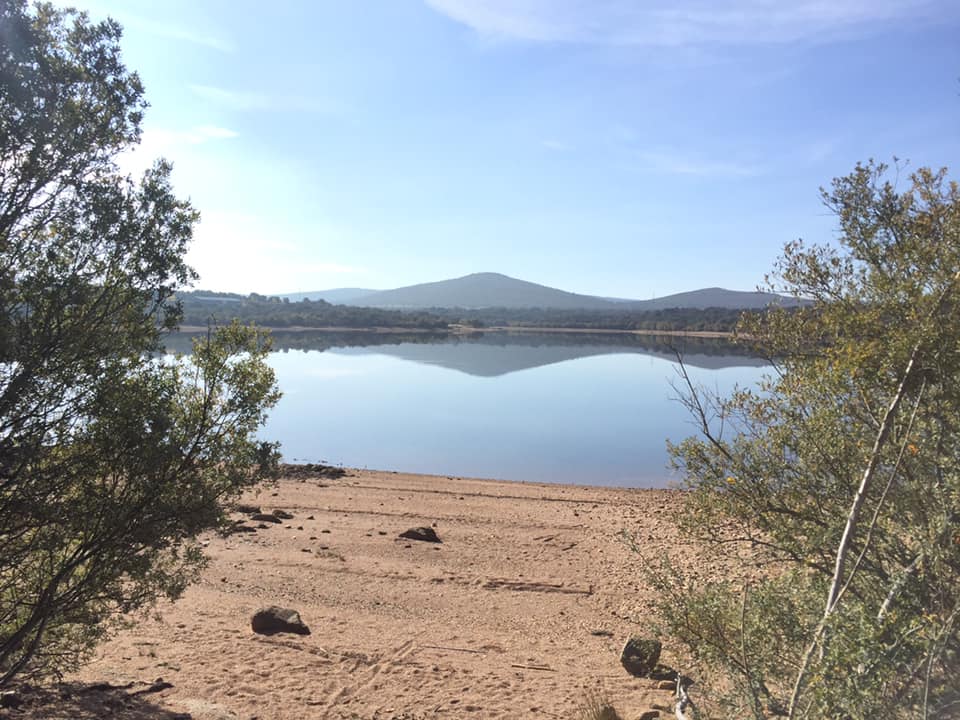
A walk alongside a reservoir was my reward for the drama of the hunting episode. I could hear faint gunshots in the distance as I progressed. I just hoped those guns weren’t targeted at the next pilgrim who tested the hunters’ patience even more than I had. Rionegro was just a short walk from there, and it also had a nice new albergue whose only drawback was its proximity to the town hall and its digital clock that chimed on the hour all though the night. The town’s restaurant was called ‘Me Gusta Comer’, translating as ‘I like eating’, which I certainly did, even if I wasn’t getting to do it with the convenience I normally enjoyed. The food there was a real gustatory treat, and a wonderful alternative to the mundane daily menu peregrino or plato combinado, the routine dinners of which none of us pilgrims had the luxury of tiring for lack of any alternative.
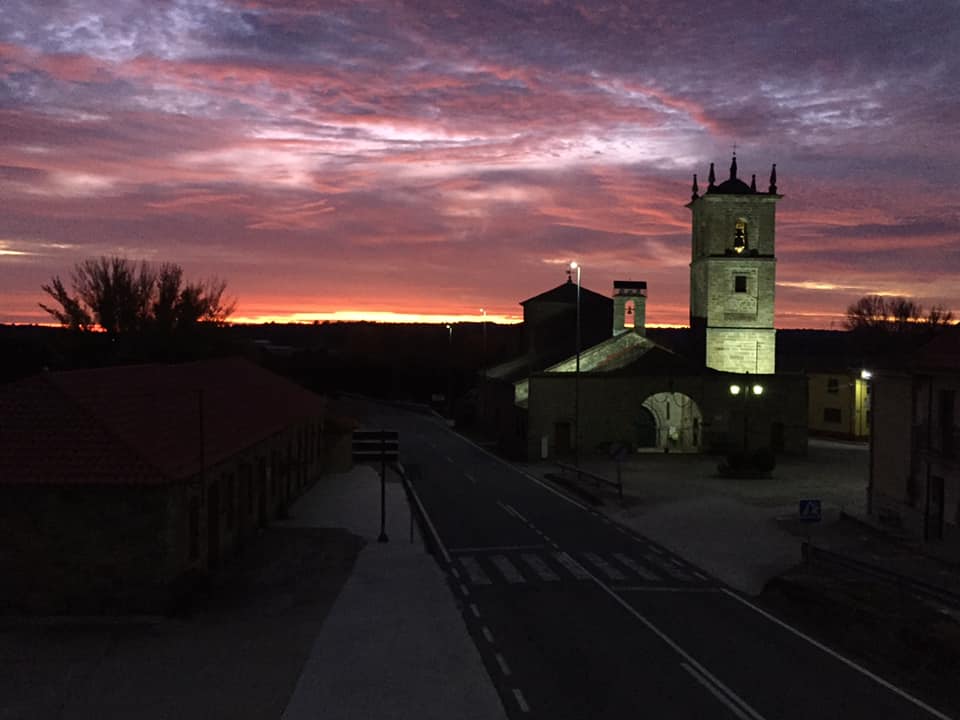
I was intending to reach Santiago by Tuesday the 5th of November, about ten days from Rionegro. I had plotted a rough itinerary to get me there, and to reach my target I had to walk 40 KM to Pueblo de Sanabria the next day. This meant saying goodbye to Ellen, Peter and Amparo, who were planning to travel shorter stages. 40 KM was a daunting distance, but it was no longer a number I was afraid of. I’d been on the road for almost a month now, and if the hunters didn’t kill me the previous day I didn’t imagine anything would.
The road from Rionegro, like many days before, was a lonely one, but it travelled through portions of deciduous woodlands, the likes of which I had only seen at the beginning of Castilla y Leon. As I travelled deeper into the forest I heard some gunshots in the distance again, and a group of deer scurried past. I was expecting to meet the Spanish equivalent of Robert DeNiro and Christopher Walken once more but I managed to complete that day without encountering anyone with a gun. However, I was subsequently accosted by a nasty group of dogs. Four of them appeared out of nowhere and charged at me as I made my way along a quiet, isolated path. I was completely defenceless, and was quite unnerved, as one hears occasional tales of pilgrims being attacked by wild – and potentially rabid – canines. I held my nerve and kept on walking, arriving at a small village just a few hundred metres later, where most of the dogs dispersed. I stopped to have my lunch there, but the most menacing of the mutts hung around to watch me. I gave him some bread as a peace offering, but when I refused to give him any more he started to growl slowly, and this developed into a more sinister bark. I stood my ground, stared him down and he eventually left. Hunters, ferocious dogs and starvation were all seen off. What was next? A global pandemic?
There were many villages along that stretch, most of which had few signs of life. There were no shops, cafes, and not even the obligatory pharmacy or hairdressers that even the ghost towns contain. Church bells announcing Sunday mass rang out as I was passing through one little place. Several front doors opened and seven or eight elderly people shuffled out and made their way to the chapel. I could not have seen a clearer indication of the impending demise of small town Spain, or small town everywhere in the Western world for that matter. Even Salamanca, a bustling university town, has little work to offer young people who are not employed in the education or tourism sector. It saddened me to see how a whole way of life was coming to an end, and the death of these villages may also hasten the demise of the Via de la Plata. Or perhaps some enterprising people could come along and find ways to keep these towns alive, and spur increasing numbers of pilgrims to walk this path. And it is such a nice path. It would be a shame if I was among the last generation to complete it.
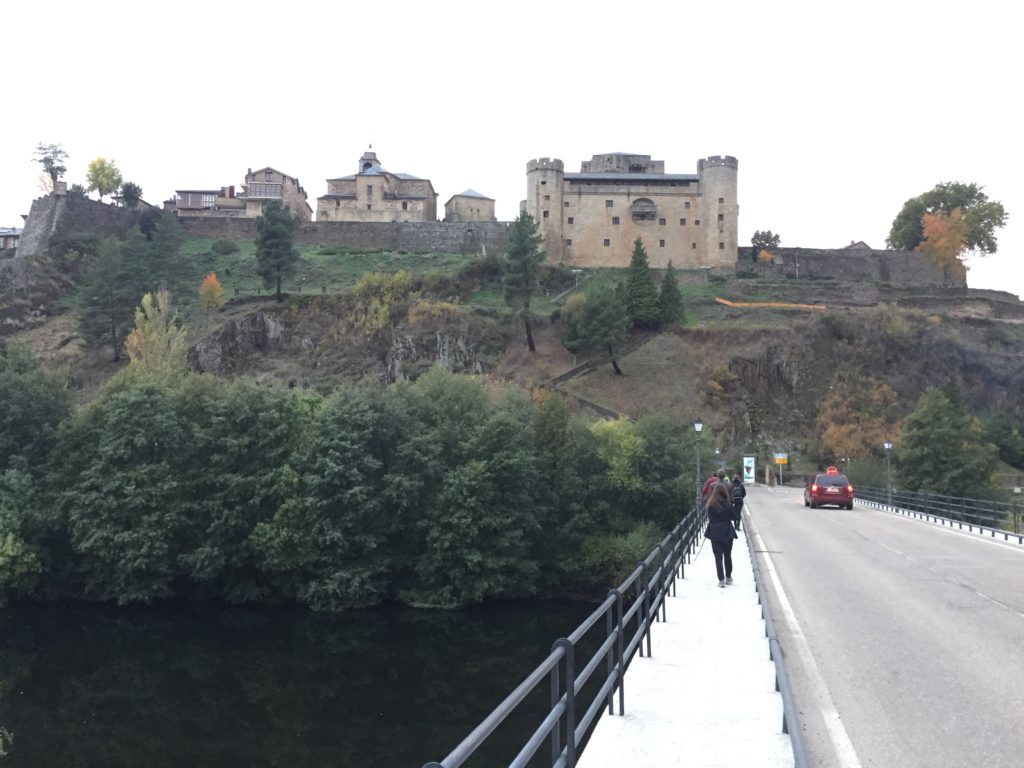
Pueblo de Sanabria, my destination that day, was an inviting medieval town with an impressive 15th Century castle perched on a hill, offering impressive views of the surrounding countryside. I reencountered Max the American here for the first time in two weeks. He still had his cumbersome wooden backpack. He’d been joined by his cousin Sahara, and a German woman, Katia, who had walked the Camino Mozarabe, a path that begins in Almeria on the Med, crosses Andalucia, and joins up with the Via de la Plata in Merida. Anyone who attempts that is truly certifiable. I wasn’t yet mad enough to think about doing it, but insanity is a progressive condition, so in another five or six years I may have reached the level of lunacy required to give it a go. After all, it had taken me 45 years before I decided to attempt the Via de la Plata.
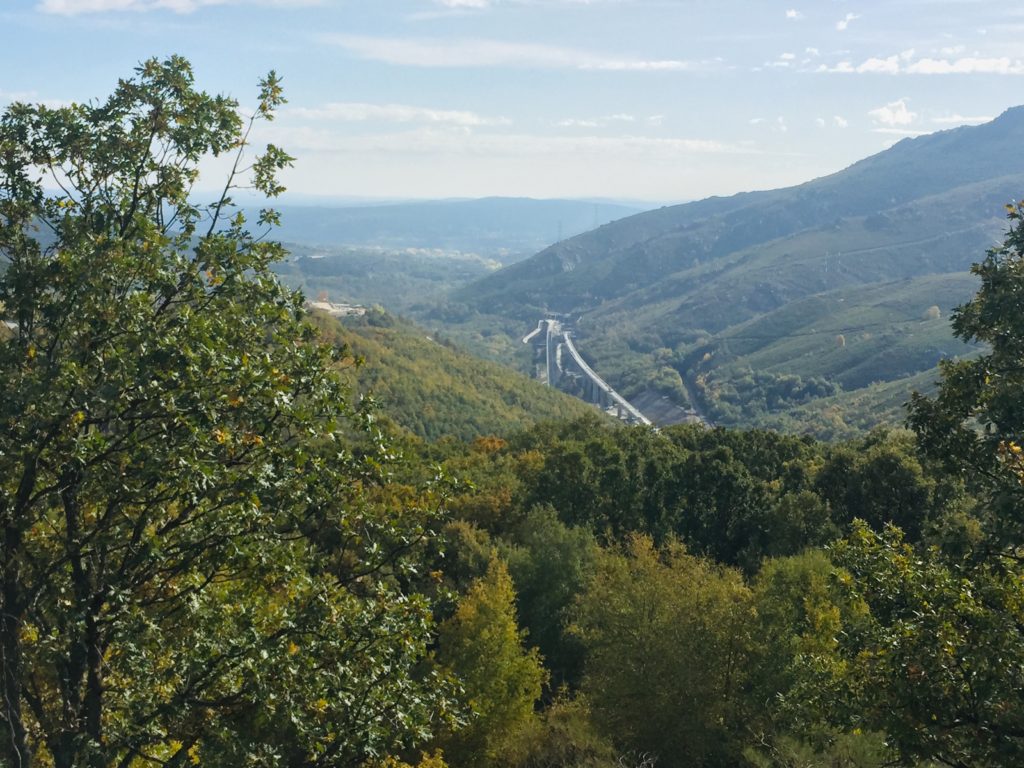
It was nice to see some familiar faces, and as the stages for the next week were fairly clearly defined I knew I would have some good company along the way. We were now heading into much more mountainous terrain as we were crossing the Cordillera Cantabrica. We were practically on the border with Portugal, and we were drawing ever nearer to Galicia and our journey’s end. The high speed AVE train was under construction in this region, causing serious disruption to the camino. I was obliged to walk long distances at the side of a busy road from Pueblo de Sanabria, while cement trucks whizzed by at regular intervals. In spite of the traffic the surrounding vistas were magnificent, and once we got off the road the walking was very pleasant indeed. This was rich, verdant, Alpine country, with sweeping views down into the valleys below. It was so unlike Spain of the popular imagination, and more like the Black Forest, or Switzerland. We ascended to 1,356 metres on that stage, the highest point on the Via de la Plata. In the village of Requejo de Sanabria I even managed to find the first open shop in two days, and I didn’t have to search around town for the shopkeeper.
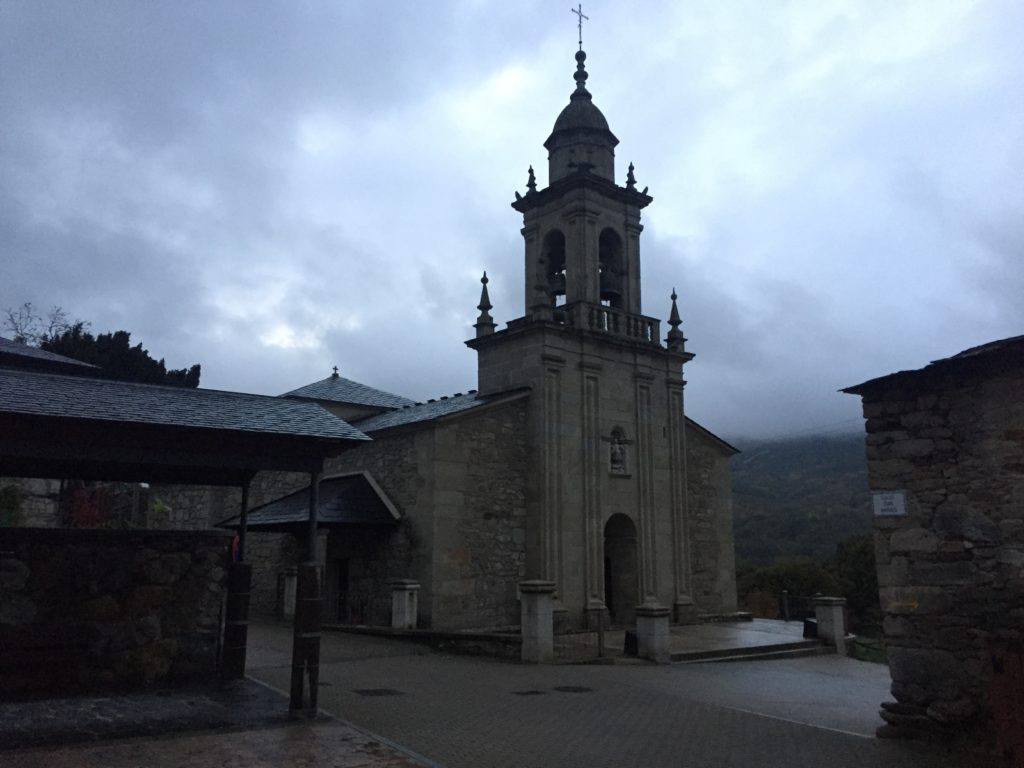
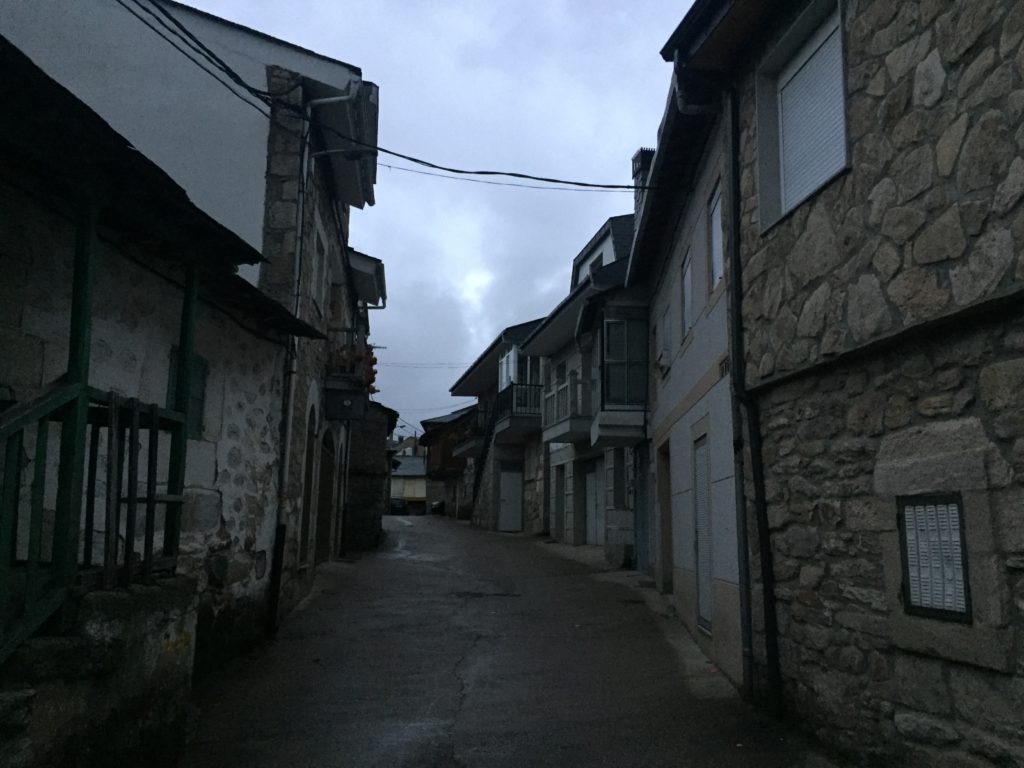
We spent that evening in the pretty stone village of Lubian, in a cosy albergue that was close to capacity. Numbers were increasing, and arguments and disputes arose among pilgrims competing for space to dry their washing. An Italian couple called Flora and Enzo made a delicious risotto, with mushrooms they had gathered from along the side of the road. Different kinds of fungus are abundant in these lush and fertile lands, although a certain degree of knowledge is required before picking them unless you want to take a camino of a different, psychedelic kind. Wild apples, pears and other fruits are similarly plentiful, so much in some spots that you had to walk carefully to avoid treading on them. For once, hunger would not be an issue. I also had the pleasure of being introduced to the delicacy of boiled wild chestnuts in Lubian. These were a little luxury for me but they became a necessity for other pilgrims. I heard horror stories from people who were snowbound in the mountains on the Camino Francés around the same time who were forced to forage for chestnuts in the woods as they were the only source of food available. The nearby shops and restaurants had closed because of a blizzard, leaving the pilgrims to their own devices.
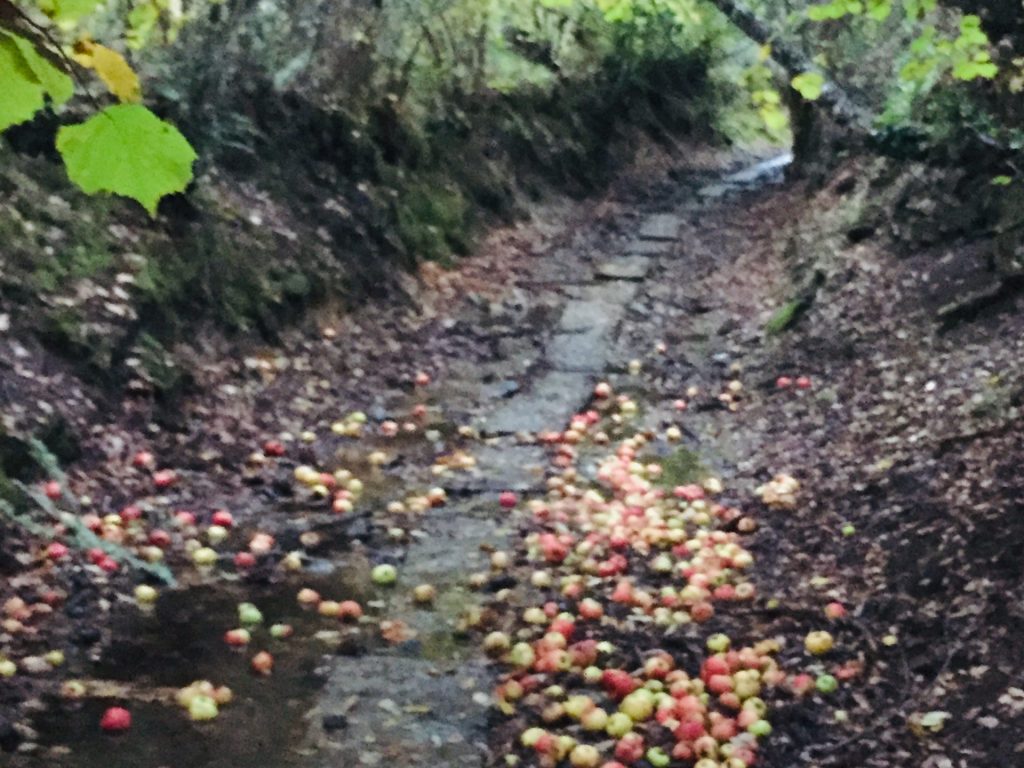
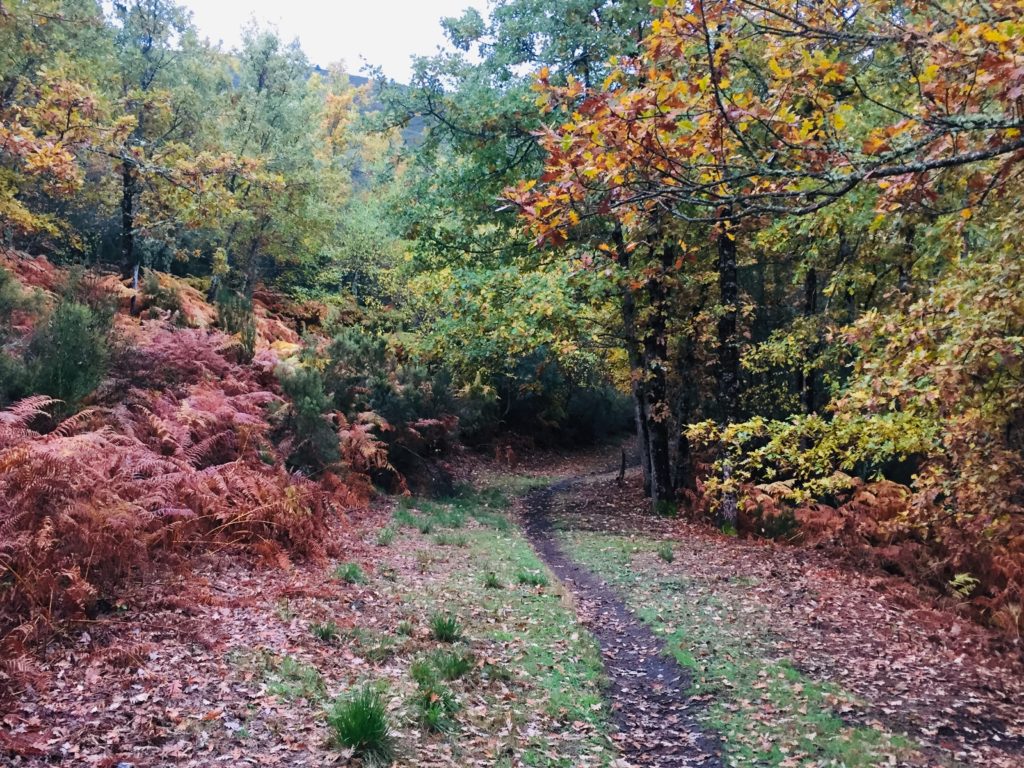
Through the fruit laden oak forests in the heavy morning fog, I had to climb 400 metres in 5 kilometres to reach the next summit and milestone. After two weeks I had come to the end of Castilla y Leon. I was now about to cross into Galicia, the home of Santiago, and Finisterre – the end of the world. It was a mild and misty day, with clouds overhead that threatened worse to come. They say in Galicia you should pray for sun but prepare for rain. I had been here enough times to know how true that statement was. I had taken just one substantial soaking so far on the Via de la Plata, with a few minor ones thrown in to remind me not to get too cocky. In my previous visits to Galicia I had experienced downpours of biblical proportions, rain that was so intense it penetrated my DNA. I had also come to realise that praying for sunshine was not a futile pursuit. My boots were now starting to wear as thin as my body, so I knew that I would have to take preparatory measures to avoid the climactic thrashings that might be heading my way. And like a drowning man, I hoped that some divine intercessory power would listen to my prayers. With those thoughts in mind, I set forth into Galicia.
John, love your descriptions of the La Plata and how you weave the story and your humor. Because we walked it and met up with you 3 times you bring me back to it all. We did take the Frances route at the split but witnessed your arrival into Santiago. We did get caught up in the snows of the Cantabrians and the downpours of Galicia. Thank you John.. look forward to 3rd blog.
Janell